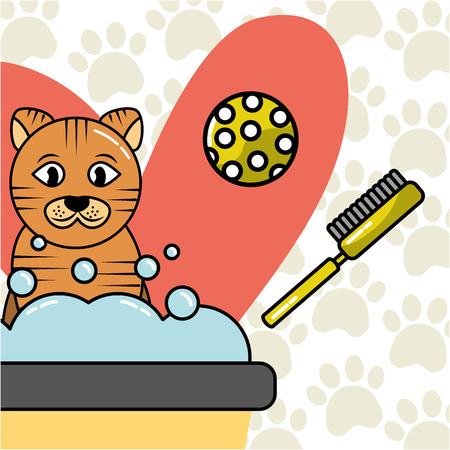1. Understanding Feline Instincts in the British Home
Cats have long been cherished companions in British households, weaving themselves into the fabric of both urban flats and countryside cottages. Despite their domestication, cats retain a deep-rooted set of natural instincts—behaviours shaped by thousands of years as both predator and prey. Whether your feline friend resides in the heart of London or a quiet Yorkshire village, these instincts manifest in daily life, revealing their intrinsic need to hunt, explore, and satisfy an insatiable curiosity about the world beyond the windowpane.
Hunting is at the core of a cat’s being, often observed in the playful pouncing on toys or the intense focus on shadows flitting across the living room floor. This behaviour isn’t just for fun; it’s an expression of their ancestral skills honed for survival. Similarly, exploration is second nature to our feline companions. Even when confined indoors for safety, many British cats will patrol every nook and cranny, climb furniture, and peer longingly through windows at fluttering birds and rustling leaves outside.
The curiosity of cats knows no bounds—an instinct that drives them to investigate new scents, sounds, and sights. In bustling city flats, this might mean perching atop a radiator to watch passersby, while in rural homes, it can involve hours spent tracking insects from behind glass doors. Regardless of location, these instinctual needs persist and shape how our cats interact with their environment.
Understanding these inherent behaviours is crucial for British cat owners striving to balance safety with enrichment. By recognising how hunting, exploring, and curiosity play out within our homes—be they compact city spaces or expansive countryside retreats—we lay the foundation for providing meaningful experiences that honour our cats’ true nature while keeping them protected from outdoor hazards unique to the UK.
2. Weighing Up the Risks: Outdoor Dangers in the UK
Allowing our beloved indoor cats a taste of the outdoors is a wonderful way to enrich their lives, but it’s essential to consider the very real risks present in the British environment. Whether you live in a bustling city or a tranquil village, each setting presents its own unique hazards that can threaten your cat’s safety and wellbeing.
Common Hazards for British Cats
Below is a table highlighting some of the most prevalent dangers faced by cats across the UK:
| Hazard | Description | Where Most Common |
|---|---|---|
| Busy Roads | High traffic areas pose significant risks of accidents, especially for curious or timid cats not used to vehicles. | Cities, Suburbs |
| Foxes & Other Wildlife | Urban foxes and larger birds of prey may see cats as competition or, rarely, as prey. | Countryside, Outskirts, Some City Parks |
| Unpredictable Weather | Suddenshowers, cold snaps, and heatwaves can catch cats off guard, leading to exposure or dehydration. | Across the UK |
| Pesticides & Poisonous Plants | Cats may come into contact with harmful substances or nibble toxic flora while exploring gardens or parks. | Countryside, Gardens Everywhere |
| Theft & Catnapping | Pedigree breeds are sometimes targeted for theft; microchipping helps but cannot prevent all incidents. | Cities, High Population Areas |
| Other Cats & Territorial Fights | Feral or neighbourhood cats can be territorial, resulting in fights or transmission of diseases like FIV. | Cities, Villages, Anywhere with Many Cats |
City vs Countryside: Different Challenges for Cats
Urban Environments: In cities, traffic is often the greatest risk. Tall buildings may also present fall dangers if cats access ledges or balconies. There’s also an increased likelihood of encountering other pets and potential exposure to pollution.
Countryside Settings: While quieter roads reduce some risks, rural locations introduce new challenges such as farm machinery, livestock, and a wider range of wildlife. Cats may roam further afield and become lost more easily in open landscapes.
Your Cat’s Personality Matters Too
No two cats are alike – some are bold adventurers while others are naturally cautious. Understanding your cat’s temperament will help you assess which risks are most relevant and how best to mitigate them when planning outdoor experiences.

3. Creating Safe and Enriching Garden Spaces
For many UK cat owners, transforming an outdoor area into a secure retreat allows their indoor cats to embrace fresh air and natural sights while remaining protected from hazards. Whether you have a compact city balcony, a classic suburban patio, or a traditional garden, there are practical ways to create safe and stimulating environments tailored to typical British properties.
Assessing Your Outdoor Space
Begin by evaluating the size and layout of your garden, patio, or balcony. Even the smallest spaces can be adapted for feline enjoyment. Consider the common features of UK homes – brick walls, wooden fences, and shared boundaries with neighbours. Each aspect offers both opportunities and challenges in creating a cat-safe zone.
Catios: The Perfect Compromise
A catio (cat patio) is an enclosed structure that gives your cat the freedom to experience the outdoors without roaming free. Prefabricated or custom-built catios can be attached to windows, doors, or directly onto patios. Many UK retailers offer modular options suitable for terraced homes and flats alike. To enrich the space, add shelves for climbing, scratching posts, and soft bedding for lounging in the sun.
Cat-Proof Fencing Solutions
If you have a larger garden, cat-proof fencing is a smart investment. Specially designed fence toppers or inward-angled mesh extensions prevent adventurous cats from scaling boundary fences. These solutions work well with standard British garden fencing and help keep cats within your property while deterring strays and wildlife from entering.
Balcony Safety Measures
For those living in flats or maisonettes, balconies can become delightful retreats with some simple adjustments. Install fine mesh panels or netting along railings to prevent curious cats from squeezing through gaps or jumping over the edge. Be sure all materials are weather-resistant and securely fitted – safety always comes first!
Adding Enrichment for Happy Cats
No matter your chosen setup, include plenty of enrichment features: potted cat-friendly plants like catnip or valerian, sturdy platforms at varying heights, and shaded spots for summer days. Rotate toys regularly to maintain interest and consider providing access to water fountains for hydration on warm afternoons.
By thoughtfully adapting your outdoor areas with these practical tips, you’ll offer your indoor cat a taste of nature’s wonders while safeguarding their wellbeing – all in harmony with the unique character of UK homes.
4. Supervised Exploration: Harnesses and Safe Walks
In the UK, harness training for indoor cats has become increasingly popular among cat guardians who wish to offer their feline companions a taste of the outdoors without compromising safety. This trend reflects a growing understanding of feline wellbeing and the importance of fulfilling their natural instincts, even in urban environments where free roaming isn’t always possible or safe.
Why Choose Harness Training?
Harness training allows cats to experience the sights, sounds, and scents of the British outdoors while ensuring they remain protected from common hazards such as traffic, dogs, and other wildlife. It also helps reduce indoor boredom and provides valuable enrichment, especially for cats living in flats or homes without gardens.
Step-by-Step Guide: Taking Your Cat on Safe Walks
| Step | Description |
|---|---|
| 1. Choosing a Harness | Select a well-fitting cat harness (not a dog harness) with adjustable straps and secure fastenings. Popular options in Britain include vest-style harnesses that distribute pressure evenly. |
| 2. Introducing the Harness Indoors | Let your cat sniff and investigate the harness before gently placing it on for short periods indoors. Use treats and gentle encouragement to build positive associations. |
| 3. Short Indoor Walks | Attach the lead and allow your cat to explore familiar rooms under supervision, gradually increasing the duration as they become more comfortable. |
| 4. Venturing Outside | Start with quiet, enclosed areas such as a private garden or courtyard. Let your cat set the pace, offering plenty of reassurance and retreating indoors if they appear stressed. |
| 5. Exploring Public Spaces Safely | If your cat is confident, consider short walks in calm neighbourhood areas. Always avoid busy roads, off-lead dogs, or crowded parks to minimise stress and danger. |
Best Practices for Acclimatising Cats to Outdoor Sights and Sounds
- Gradual Exposure: Increase outdoor time slowly, allowing your cat to observe birds, squirrels, and typical British garden life at their own pace.
- Scent Enrichment: Encourage natural behaviours by letting your cat sniff plants, grass, and safe objects. Avoid contact with unknown flora that may be toxic.
- Positive Reinforcement: Reward calm behaviour with treats or gentle praise to reinforce confidence during outdoor exploration.
- Observation and Patience: Watch for signs of anxiety (flattened ears, crouching) and return indoors if your cat becomes overwhelmed. Every cat’s comfort level is unique—some adapt quickly, while others need more time.
- Routine: Consistent timing and locations help build familiarity and reduce stress for both you and your feline companion.
The British Take on Cat Walks
Embracing supervised walks not only supports your cat’s physical health but also strengthens your bond through shared adventure—an approach that aligns beautifully with Britain’s love of animal welfare and responsible pet ownership. By taking these careful steps, you can safely balance your indoor cat’s curiosity with the joys of the great British outdoors.
5. Bringing the Outdoors In: Indoor Enrichment Ideas
Even if your cat spends most or all of its time indoors, you can still provide enriching experiences that echo the charms of the British outdoors. Cats are natural hunters and explorers, so recreating elements of nature inside your home not only satisfies their instincts but also helps prevent boredom and stress.
Safe Indoor Plants for a Touch of Nature
Start by introducing safe, non-toxic plants like cat grass (Dactylis glomerata), spider plants, or even a small pot of valerian. These green touches bring a bit of the countryside into your living space while allowing your cat to nibble and sniff safely. Avoid lilies and other toxic plants commonly found in British gardens; always double-check plant safety before bringing anything new indoors.
Window Perches with a View
Cats love to watch the world go by, so set up a cosy window perch where they can observe birds, squirrels, and passing neighbours. Choose a sunny spot and add a comfortable blanket or cushion—bonus points if you can place bird feeders outside to attract local wildlife for feline entertainment. This simple addition mimics the experience of prowling in a garden or basking in the sun on a typical English afternoon.
Interactive Play that Mimics Hunting
To satisfy your cat’s hunting instincts, invest in interactive toys such as feather wands, motorised mice, or puzzle feeders filled with treats. Rotate these toys regularly to keep things fresh and exciting. Try hiding treats around the house for your cat to “hunt”—a wonderful way to engage their senses and stimulate problem-solving skills reminiscent of tracking prey outdoors.
Bringing Local Scents Indoors
If you have access to an outdoor area free from pesticides, collect small twigs, leaves, or tufts of grass (making sure they’re safe) and place them in a box for your cat to explore. The familiar scents and textures will spark curiosity and provide mental stimulation without any risk.
Create Vertical Exploration Spaces
British cats adore climbing trees and fences, so replicate this by adding cat trees, shelves, or climbing frames. Vertical spaces allow your indoor cat to survey their “territory” just as they would outside, keeping them active and content within the safety of your home.
6. Local Community and Resources
When it comes to providing safe outdoor experiences for your indoor cat in the UK, tapping into local knowledge and resources can make all the difference. Fortunately, British cat owners have access to a wealth of support through established organisations, neighbourhood networks, and products tailored to our unique environment and feline welfare standards.
Connect with UK Feline Welfare Organisations
Start by exploring respected charities such as Cats Protection and the RSPCA. These organisations offer practical advice on enriching your cat’s environment, guidelines for safe garden access, and even workshops or events in many communities. Their helplines and websites are brimming with information specific to British homes and gardens, taking into account our weather, wildlife, and neighbourhood layouts.
Engage with Online Cat Communities
British cat owners are a passionate bunch, and there are thriving online forums and social media groups where you can swap tips, ask questions, and share experiences about giving your indoor cat a taste of the outdoors. Look out for Facebook groups like “UK Indoor Cats” or “Catios & Cat Enclosures UK”—these spaces offer real-life stories, product recommendations, and sometimes even local meet-ups or garden tours for inspiration.
Find Products Designed for British Homes
The UK market offers an array of products specifically created for our climate and housing styles. From modular catios that suit smaller terraced gardens to escape-proof harnesses suitable for rainy strolls, you’ll find everything you need at major pet retailers such as Pets at Home or independent specialists like ProtectaPet. Many companies also provide installation services or bespoke designs—perfect if you live in a flat or listed building where modifications must be discreet.
Get Involved Locally
If you’re keen to give back while learning more, consider volunteering with local rescue centres or attending community cat walks organised by charities. Not only will you pick up new ideas for stimulating your own cat safely, but you’ll also help promote responsible feline care across your area.
By making use of these local resources—whether it’s expert advice from a charity, friendly chats in online groups, or investing in UK-specific products—you can confidently balance your cat’s natural instincts with their safety. Remember: the journey is easier when you’re part of a supportive community that shares your love for happy, healthy cats.


